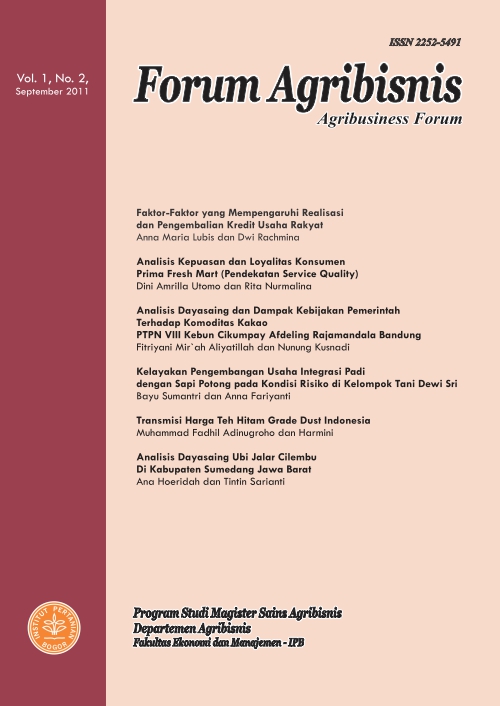ANALISIS DAYASAING UBI JALAR CILEMBU DI KABUPATEN SUMEDANG JAWA BARAT
Main Article Content
Abstract
Today, Indonesia is still export fresh agriculture product with low selling price and competitive power than processed product with higher selling price. The condition also observed for sweet potato that exported in the fresh form with low selling price and in turn lowering the competitive power of this product. Province of West Java is one of sweet potato production center. In 2009, “Cilembu” sweet potato becomes leading product of this commodity group that mostly produced in Subang Regency. Market destination of “Cilembu” is not only for domestic demand but also exported to many destination countries including Japan, Malaysia, Vietnam, Hongkong, and Singapore, but selling in the fresh form. Due to the large potential, it is important to examine the competitive power of the commodity and effect of government policy on “Cilembu” farming in Subang Regency. The research study was selected on purposive basis. The data analyzed using Policy Analysis Matrix (PAM) and sensitivity analysis. The result indicated that “Cilembu” farming in Sumedang Regency is profitable both financial and economic and has good competitive power (either comparative or competitive advantage). Government policy on domestic input is not effective yet because producer must pay higher price on the input than it should be. The policy is effective for tradable input due to subsidy. Output policy has restrictive nature due to export taxes and no subsidy for the commodity. Sensitivity analysis show that increasing of labor wage and changing on exchange rate is not affect competitive and comparative advantage, while decreasing on output will affect on competitive advantage (comparative advantage still exist).
Downloads
Download data is not yet available.
Article Details
How to Cite
HoeridahA., & SariantiT. (2011). ANALISIS DAYASAING UBI JALAR CILEMBU DI KABUPATEN SUMEDANG JAWA BARAT. Forum Agribisnis : Agribusiness Forum, 1(2), 200-216. https://doi.org/10.29244/fagb.1.2.200-216
Section
Articles
The author submitting the manuscript must understand and agree that the copyright of the article manuscript must be submitted/transferred to the Journal Forum Agribisnis. This work is licensed under the Creative Commons Attribution-ShareAlike 4.0 (CC BY-SA) International License in which the Author and Reader can copy and redistribute the material in any media or format, and remix, modify and build material for any purpose, but they must provide appropriate credit (citing articles or content), provide a link to the license, and indicate whether there is a change. If you mix, change, or create material, you must distribute your contribution under the same license as the original.

